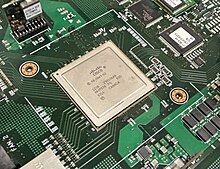
Back دارة متكاملة محددة التطبيق Arabic Circuit integrat d'aplicació específica Catalan Zákaznický integrovaný obvod Czech ASIC Danish Anwendungsspezifische integrierte Schaltung German Circuito integrado de aplicación específica Spanish Rakendus-spetsiifiline integraallülitus Estonian مدارهای مجتمع با کاربرد خاص Persian ASIC Finnish Application-specific integrated circuit French
This article includes a list of general references, but it lacks sufficient corresponding inline citations. (October 2015) |


An application-specific integrated circuit (ASIC /ˈeɪsɪk/) is an integrated circuit (IC) chip customized for a particular use, rather than intended for general-purpose use, such as a chip designed to run in a digital voice recorder or a high-efficiency video codec.[1] Application-specific standard product chips are intermediate between ASICs and industry standard integrated circuits like the 7400 series or the 4000 series.[2] ASIC chips are typically fabricated using metal–oxide–semiconductor (MOS) technology, as MOS integrated circuit chips.[3]
As feature sizes have shrunk and chip design tools improved over the years, the maximum complexity (and hence functionality) possible in an ASIC has grown from 5,000 logic gates to over 100 million. Modern ASICs often include entire microprocessors, memory blocks including ROM, RAM, EEPROM, flash memory and other large building blocks. Such an ASIC is often termed a SoC (system-on-chip). Designers of digital ASICs often use a hardware description language (HDL), such as Verilog or VHDL, to describe the functionality of ASICs.[2]
Field-programmable gate arrays (FPGA) are the modern-day technology improvement on breadboards, meaning that they are not made to be application-specific as opposed to ASICs. Programmable logic blocks and programmable interconnects allow the same FPGA to be used in many different applications. For smaller designs or lower production volumes, FPGAs may be more cost-effective than an ASIC design, even in production. The non-recurring engineering (NRE) cost of an ASIC can run into the millions of dollars. Therefore, device manufacturers typically prefer FPGAs for prototyping and devices with low production volume and ASICs for very large production volumes where NRE costs can be amortized across many devices.[4]
- ^ Golshan, Khosrow (2007). Physical Design Essentials: An ASIC Design Implementation Perspective. Boston, MA: Springer. ISBN 978-0-387-36642-5.
- ^ a b Barr, Keith (2007). ASIC Design in the Silicon Sandbox: A Complete Guide to Building Mixed-signal Integrated Circuits. New York: McGraw-Hill. ISBN 978-0-07-148161-8. OCLC 76935560.
- ^ Cite error: The named reference
computerhistory1967was invoked but never defined (see the help page). - ^ Kriegbaum, Jeff (13 September 2004). "FPGA's vs. ASIC's". EE Times.